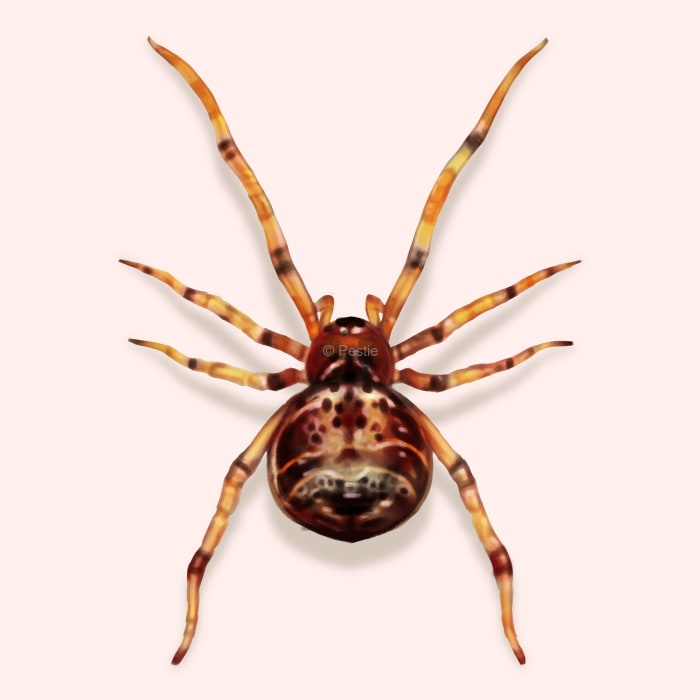How to identify and get rid of American house spiders

All American: football, apple pie, and… house spiders?
They lurk in the corners, dangling from ceilings, and comfortably live in your home. And yet, as menacing as that sounds, American house spiders keep to themselves and may be beneficial. Plus, they don’t mind taking up a tiny spot in your house for their services.
These tiny spiders build messy cobwebs in our garages, basements, or crawlspaces. They are very common in households and have a unique relationship with humans. Our climate-controlled homes, with all our nooks and crannies, make the perfect habitat for these kinds of spiders.
American house spiders go by several names, including the common house spider. They are closely related to black widows and a whole family of comb-footed spiders. The comb-footed name comes from the comb-like structure on their feet that they use to handle webs and throw them at their prey.
Dealing with spiders in your home is a nightmare to some, but these common spiders are busy eating up mosquitoes, flies, and ants, doing their job to rid your home of pests.
How to identify American house spiders
American house spiders are prevalent in North America. You can quickly identify them by their tangled webs in less-disturbed areas like corners of rooms, basements, and garages. Their abdomen is very round with chevron-like markings. They also have long yellow legs with dark bands.
An infestation sign includes noticing an increased number of spiders and webs across different parts of your home. You can also look for egg sacs within these webs as a clear indicator of a growing spider population. The egg sacs have a tan outer layer that is very papery. Inside the egg sac are between 150 and 200 eggs.
How big are American house spiders?
American house spiders are generally small, with a body length of about ¼ to ⅜ inches. Females are bigger than males and are the ones in the webs.
What other spiders look like an American house spider?
These small spiders can be mixed up with many household spiders, including cellar spiders, black widows, or other cobweb spiders. Look for the tan coloration and darker banding on the legs to tell them apart.
Where do American house spiders live?
You can find American house spiders throughout North America, north of Mexico. They thrive in man-made structures and have a close relationship with humans, living harmlessly with them.
Inside homes, they prefer corners of rooms, window frames, basements, and attics. They might be outdoors in sheds, under eaves, or in any sheltered spots with less human activity.
How to get rid of American house spiders
If you frequently find American house spiders inside your house, consider these options to eliminate them and prevent them from coming back:
- Regular cleaning: Reduce clutter and vacuum regularly to remove spiders, webs, and egg sacs. Dusting in corners can prevent spiders from building webs.
- Seal entry points: Fix screens on windows and doors and seal cracks around the house to prevent their entry.
- Reduce outdoor lighting: Minimize outdoor lights that attract insects, which can attract spiders looking for prey.
- Maintain a Dry Environment: Spiders are attracted to moisture, so using dehumidifiers in basements and ensuring good ventilation can help deter them.
- Use a barrier spray: Spraying a perimeter spray in and around your home can keep spiders and insects from coming inside. Pestie offers a DIY spray that is an easy way to keep pests away throughout the year!
Treat common house spiders with Pestie
If you're still having trouble keeping common house spiders away, the best option is to use a pro-grade, effective pest control solution like Pestie.
Pestie is a do-it-yourself pest control solution that's specially designed to keep common house spiders and other pests away from your home.
With Pestie, you can rest easy knowing that your living space is protected and free of creepy crawlies. And the best part? It's designed for people, pets, and the planet, so you can say goodbye to harsh chemicals and hello to peace of mind!
- Save hundreds compared to traditional annual pest plans
- People, pet, and planet-friendly
- Pro-grade customized formulas
Quick facts
- Scientific name
Parasteatoda Tepidariorum
- Other common names
American House Spiders
- Colors
Brown or grayish body with various markings
- Life span
1+ year when inside
- Diet
Flies, mosquitoes, ants, sometimes larger insects like grasshoppers and cockroaches, and other spiders
How dangerous are Common House Spiders?
Low danger risk
American House Spiders are not considered dangerous to humans; their venom is not potent enough to cause significant harm. If they are grabbed or squeezed, they will try to bite. The bite is about the same pain as a bee sting.
American house spiders can throw their web at their prey. They’ve also been known to lure baby skinks into their webs by dangling dead flies from the web. The skinks get caught in the web, and the spiders catch them.








